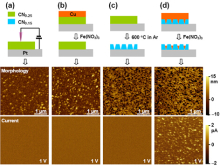 04/09/2015The Progress in Synthesis of Large CVD Diamond Single Crystals
04/09/2015The Progress in Synthesis of Large CVD Diamond Single Crystals
“Functional Carbon Materials R&D Group”at CNITECH has achieved a series of technical breakthroughs in synthesis of large-size CVD diamond single crystals.They successfully exploited MPCVD equipment that can generate high-density, stable plasma available for high-speed single crystalline diamond growth.
 04/09/2015Modulating Magnetic Anisotropy by Stress/Strain in Flexible Magnetic Thin Films
04/09/2015Modulating Magnetic Anisotropy by Stress/Strain in Flexible Magnetic Thin Films
The magneto electronic materials and devices group in CAS Key Laboratory of Magnetic Materials and Devices focuses on the fabrication of flexible magneto electeonic material sand devices, and the evolution of their physical properties under multi-fields. Up to now, a series of progresses have been made regarding the modulation of magnetic anisotropy by stress/strain in flexi...
 04/07/2015A Highly Efficient Graphene Dispersion Technique Has Been Developed by NIMTE, Chinese Academy of Sciences
04/07/2015A Highly Efficient Graphene Dispersion Technique Has Been Developed by NIMTE, Chinese Academy of Sciences
Prof.Yu Haibin's group has designed and synthesized a series of highly efficient graphene dispersing agents. These novel graphene dispersing agents combine ease of synthesis, less synthetic step, low cost and without using any organic solvents during the synthesis, enabling to develop a facile approach to large-scale production of aqueous or organic graphene dispersions, as...
 04/03/2015Progress on Carbon-based Electronic Devices
04/03/2015Progress on Carbon-based Electronic Devices
Prof. Hongtao Cao and Prof. Fei Zhuge successfully synthesized an amorphous carbon thin film with through conical pores of several tens of nanometers in size by annealing magnetron sputtered nitrogen-doped carbon thin films at elevated temperature in an inert atmosphere
 04/01/2015Ba9Lu2Si6O24:Ce3+, an Efficient Green Phosphor with High Thermal and Radiation Stability for Solid State Lighting
04/01/2015Ba9Lu2Si6O24:Ce3+, an Efficient Green Phosphor with High Thermal and Radiation Stability for Solid State Lighting
Prof.Haochuan Jiang’s group,Jun Jiang and Dr. Yongfu Liu at the Ningbo Institute of Materials Technology and Engineering, Chinese Academy of Sciences develop a novel orthosilicate phosphor, Ba9Lu2Si6O24:Ce3+, which is synthesized by a simple SSR processing technology at a relatively low reaction temperature of 1200-1400 oC.